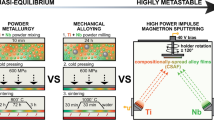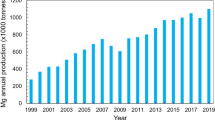Abstract
Microstructures of a duplex-phase Zr-2.5Nb alloy treated by pulsed laser were characterized by electron backscatter diffraction (EBSD) and electron channeling contrast (ECC) imaging techniques. Major attention has been paid to non-equilibrium hybrid microstructure consisting of both prior α and β phases, and α plates transformed from new β phases to probe α→β transformation characteristics in the alloy. The origin of the hybrid microstructure is attributed to the specific thermodynamic conditions induced by the pulsed laser treatment. ECC observation shows that newly formed β phases during laser heating prefer to nucleate and grow at the expense of edges of prior α grains rather than their interiors. EBSD analyses further reveal that orientations of the new β phases are not determined by the prior α grains according to the Burgers relationship but maintain those of the prior β phases in an epitaxial growth way.
Similar content being viewed by others
References
Zinkle S J, Was G S. Materials challenges in nuclear energy. Acta Mater, 2013, 61: 735–758
Chai L, Luan B, Murty K L, et al. Twinning during recrystallization cooling in a-Zr alloy. Mater Sci Eng-A, 2013, 576: 320–325
Chen L, Zeng Q, Li J, et al. Effect of microstructure on corrosion behavior of a Zr-Sn-Nb-Fe-Cu-O alloy. Mater Des, 2016, 92: 888–896
Chai L, Luan B, Xiao D, et al. Microstructural and textural evolution of commercially pure Zr sheet rolled at room and liquid nitrogen temperatures. Mater Des, 2015, 85: 296–308
Liang J, Zhang M, Ouyang Y, et al. Contribution on the phase equilibria in Zr-Nb-Fe system. J Nucl Mater, 2015, 466: 627–633
Hiwarkar V D, Sahoo S K, Mani krishna K V, et al. Coarsening of second phase in a two-phase Zr-2.5Nb: On the role of phase boundaries. Acta Mater, 2009, 57: 5812–5821
Yang Z N, Zhang F C, Qu L, et al. Formation of duplex microstructure in Zr-2.3Nb alloy and its plastic behaviour at various strain rates. Int J Plasticity, 2014, 54: 163–177
Northwood D O, Lim D T. Phase transformations in zirconium and its alloys. Canadian Metall Q, 1979, 18: 441–467
Feng Z H, Jiang X J, Zhou Y K, et al. Influence of beryllium addition on the microstructural evolution and mechanical properties of Zr alloys. Mater Des, 2015, 65: 890–895
Yang H L, Kano S, Matsukawa Y, et al. Effect of molybdenum on microstructures in Zr-1.2Nb alloys after ß-quenching and subsequently 873 K annealing. Mater Des, 2016, 104: 355–364
Dahlbäck M, Limbäck M, Hallstadius L, et al. The effect of betaquenching in final dimension on the irradiation growth of tubes and channels. J ASTM Int, 2005, 2: 276–304
Li Y, Rogge R, Holt R A. Development of local microstructure and crystallographic texture in extruded Zr-2.5Nb tubes. Mater Sci Eng-A, 2006, 437: 10–20
Maßsih A R, Andersson T, Witt P, et al. Effect of quenching rate on the ß-to-a phase transformation structure in zirconium alloy. J Nucl Mater, 2003, 322: 138–151
Srivastava D, Mukhopadhyay P, Banerjee S, et al. Morphology and substructure of lath martensites in dilute ZrNb alloys. Mater Sci Eng-A, 2000, 288: 101–110
Kim H G, Baek J H, Kim S D, et al. Microstructure and corrosion characteristics of Zr-1.5Nb-0.4Sn-0.2Fe-0.1Cr alloy with a ß-annealing. J Nucl Mater, 2008, 372: 304–311
Ben Ammar Y, Aoufi A, Darrieulat M. Influence of the cooling rate on the texture and the microstructure of Zircaloy-4 studied by means of a Jominy end-quench test. Mater Sci Eng-A, 2012, 556: 184–193
Gey N, Humbert M, Gautier E, et al. Study of the ß?a variant selection for a zircaloy-4 rod heated to the ß transus in presence or not of an axial tensile stress. J Nucl Mater, 2004, 328: 137–145
Daymond M R, Holt R A, Cai S, et al. Texture inheritance and variant selection through an hcp-bcc-hcp phase transformation. Acta Mater, 2010, 58: 4053–4066
Romero J, Preuss M, Quinta da Fonseca J. Texture memory and variant selection during phase transformation of a zirconium alloy. Acta Mater, 2009, 57: 5501–5511
Chai L, Chen B, Wang S, et al. Microstructural changes of Zr702 induced by pulsed laser surface treatment. Appl Surface Sci, 2016, 364: 61–68
Chai L, Chen B, Wang S, et al. Microstructural characteristics of a commercially pure Zr treated by pulsed laser at different powers. Mater Charact, 2015, 110: 25–32
Zaefferer S, Elhami N N. Theory and application of electron channelling contrast imaging under controlled diffraction conditions. Acta Mater, 2014, 75: 20–50
Chai L J, Wang S Y, Luan B F, et al. Electron backscatter diffraction investigation of duplex-phase microstructure in a forged Zr-2.5Nb alloy. Sci China Tech Sci, 2016, 59: 673–679
Chai L, Chen B, Zhou Z, et al. A special twin relationship or a common Burgers misorientation between a plates after ß quenching in Zr alloy? Mater Charact, 2015, 104: 61–65
Kim H G, Park J Y, Jeong Y H. Phase boundary of the Zr-rich region in commercial grade Zr-Nb alloys. J Nucl Mater, 2005, 347: 140–150
Choo K N, Kang Y H, Pyun S I, et al. Effect of composition and heat treatment on the microstructure and corrosion behavior of Zr-Nb alloys. J Nucl Mater, 1994, 209: 226–235
Hiwarkar V D, Sahoo S K, Samajdar I, et al. Annealing of cold worked two-phase Zr-2.5Nb: Associated microstructural developments. J Nucl Mater, 2009, 384: 30–37
Hovington P, Pinard P T, Lagacé M, et al. Towards a more comprehensive microstructural analysis of Zr-2.5Nb pressure tubing using image analysis and electron backscattered diffraction (EBSD). J Nucl Mater, 2009, 393: 162–174
Banerjee S, Krishnan R. Martensitic transformation in zirconium-niobium alloys. Acta Metall, 1971, 19: 1317–1326
Srivastava D, Madangopal K, Banerjee S, et al. Self accomodation morphology of martensite variants in Zr-2.5wt%Nb alloy. Acta Metall Mater, 1993, 41: 3445–3454
Burgers W G. On the process of transition of the cubic-body-centered modification into the hexagonal-close-packed modification of zirconium. Physica, 1934, 1: 561–586
Chai L, Luan B, Zhang M, et al. Experimental observation of 12 a variants inherited from one ß grain in a Zr alloy. J Nucl Mater, 2013, 440: 377–381
Gey N, Gautier E, Humbert M, et al. Study of the a/ß phase transformation of Zy-4 in presence of applied stresses at heating: Analysis of the inherited microstructures and textures. J Nucl Mater, 2002, 302: 175–184
Wenk H R, Lonardelli I, Williams D. Texture changes in the hcpbcchcp transformation of zirconium studied in situ by neutron diffraction. Acta Mater, 2004, 52: 1899–1907
Sattari M, Holt R A, Daymond M R. Variant selection and transformation texture in zirconium alloy Excel. J Nucl Mater, 2014, 453: 120–123
Seward G G E, Celotto S, Prior D J, et al. In situ SEM-EBSD observations of the hcp to bcc phase transformation in commercially pure titanium. Acta Mater, 2004, 52: 821–832
Cayron C. Importance of the a-ß transformation in the variant selection mechanisms of thermomechanically processed titanium alloys. Scripta Mater, 2008, 59: 570–573
Tiwari G P, Sharma B D, Raghunathan V S, et al. Self- and solutediffusion in dilute zirconium-niobium alloys in ß-phase. J Nucl Mater, 1973, 46: 35–40
Author information
Authors and Affiliations
Corresponding authors
Rights and permissions
About this article
Cite this article
Chai, L., Wang, S., Wu, H. et al. α→β Transformation characteristics revealed by pulsed laser-induced non-equilibrium microstructures in duplex-phase Zr alloy. Sci. China Technol. Sci. 60, 1255–1262 (2017). https://doi.org/10.1007/s11431-016-9038-y
Received:
Accepted:
Published:
Issue Date:
DOI: https://doi.org/10.1007/s11431-016-9038-y




